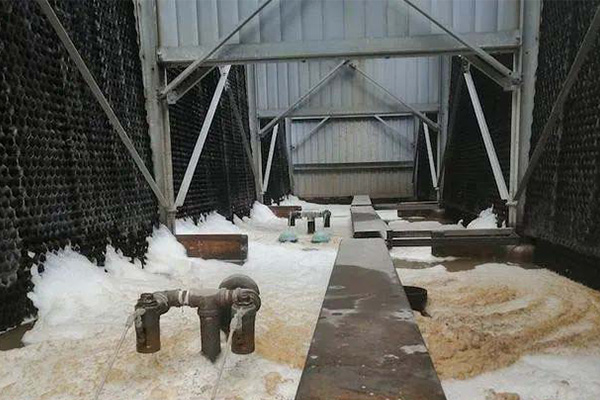The cooling tower, being exposed to outdoor environments for prolonged periods, accumulates a significant amount of sediment and debris due to its powerful fan suction. As time passes, these impurities gradually decrease the cooling tower's heat dissipation efficiency, resulting in clogged spray nozzles and increased infiltration of sediment and dirt into the cooling water system, severely impacting the system's refrigeration function. So how to do the regular cleaning of the cooling tower is crucial.
Cleaning Treatment Process:
1. Scheme One: Shutdown Cleaning
This scheme consists of sterilization and algae-killing cleaning, descaling cleaning, pre-filming, and post-cleaning cleaning stages. The entire cleaning process requires shutdown and takes about 8 days, achieving a descaling rate of over 95%.
1.1 Water Flushing: High-speed flushing (>0.15m/s) effectively removes loose dirt, sediment, detached algae, and corrosion products from the system, while checking for leaks.
1.2 Sterilization and Algae Killing Cleaning: Inject sterilization and algae killing agents to eliminate microorganisms in the system and promote the detachment and shedding of biological sludge from the equipment surface. Stop cleaning when the system turbidity stabilizes.
1.3 Descaling Cleaning with Cleaning Solution: Add a cleaning agent to dissolve scale and oxides, which are then discharged with water. Monitor the concentration of the cleaning solution, metal ion concentration, temperature, pH value, etc., and end the cleaning when the metal ion concentration stabilizes.

1.4 Post-Cleaning Rinsing: Further rinse to remove residual cleaning solution and impurities, continuously monitoring pH and turbidity, and end rinsing when both stabilize.
1.5 Pre-filming: Form a complete and corrosion-resistant protective film on the cleaned active metal surface or damaged protective film.
1.6 Post-Cleaning Equipment Cleaning: Perform deep cleaning on the cooler evaporator, use a special tube cleaner to clear each tube of the cooler, and consider separate cleaning of the cooler with an open-loop system if necessary. Thoroughly rinse the evaporator with high-pressure water to remove internal deposits, also considering separate cleaning of the external loop system if necessary.
This scheme can be carried out while the unit is running normally, with a cleaning cycle of about 30 days. After cleaning, a maintenance agent is added, and the entire process does not affect the operation of the unit.
Neutral Cleaning Agent Characteristics:
2.1 Non-corrosive: Adding to the central air conditioning water system does not change the water pH value or corrode metals, completely solving the corrosion risk brought by traditional strong acid cleaning agents.
2.2 Efficient Cleaning: Significant removal effect on various scales, difficult-to-soluble sulfates, and algae biological sludge, with a descaling rate of over 95%, restoring equipment performance and maintaining clean operation.
Neutral Cleaning Principle:
Based on the coordination field chemical theory, the d orbitals of metal ions undergo energy level splitting under the action of a specific coordination compound electrostatic field. When interacting with calcium and magnesium scales, the compound destroys the molecular structure of the scale, dissolving it in water, and discharges it through drainage.
Maintenance:
After cleaning, chemical agents are applied to the cooling water and refrigerant water systems. Corrosion and scale inhibitors are added to the refrigerant water system to prevent corrosion and scale formation.
H.Stars: Best china Industrial cooling tower! High efficiency,low noise Industrial cooling tower,round shape or square shape cooling tower etc. Accept custom.
评论
发表评论